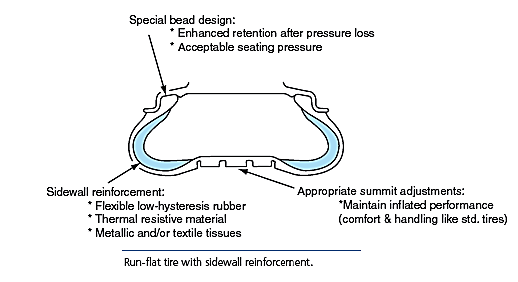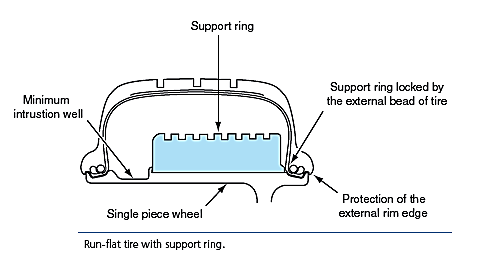SKEDSOFT
Introduction:
Some tire manufacturers have recently designed run-flat tires. Run-flat tires may be called extended mobility tires (EMT). Run-flat tires eliminate the need for a spare tire and a jack, saving both weight and space. Run-flat tires are designed with stiffer sidewalls that will partially support the vehicle weight without air pressure in the tire.
Design objectives of Run flat tires:
Run-flat tires share these same basic design objectives:
1. Minimize the difference between run-flat tires and conventional tires when the tires are inflated.
2. Enhance the handling and riding capabilities of run-flat tires when inflated.
3. Provide acceptable handling when run-flat tires have zero pressure on various vehicles.
4. Enhance low-pressure and zero-pressure bead retention on run-flat tires.
5. Provide sufficient zero-pressure durability so the vehicle can be driven a reasonable distance to a repair facility.
Run-Flat Tires with Sidewall Reinforcements

- One of the most important requirements for run-flat tires is bead retention when running with low or zero pressure. Run-flat tires have improved beads to meet this requirement.
- Some run-flat tires have sidewall reinforcements that may be manufactured from flexible, low hysteresis rubber, thermal resistive materials, or metallic and/or textile tissues.
- Run-flat tires with high aspect ratio require increased sidewall stiffness compared to run-flat tires with a low aspect ratio.
- Because of these sidewall reinforcements, run-flat tires are 20 to 40 percent stiffer compared to conventional tires.
Run-Flat Tires with Support Ring

- This type of run-flat tire has a mechanical locking bead system, which “latches” the bead to the rim.
- The outer part of this locking bead fits down over the outer edge of the rim rather than being tucked inside the edge of the rim as it is on a conventional rim.
- The inner part of the locking bead system is mounted inside the outer edge of the rim. Additional load on the tire tends to tighten the latching force on the locking bead.
- The run-flat tire’s modified shape provides improved tread grip and vehicle handling plus reduced rolling resistance. The disadvantages of this type of run-flat tire are the special rim that is required and the extra weight of the support ring. A tire pressure monitoring system is used with this type of run-flat tire.